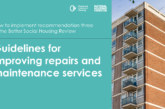Members of the National Housing Federation and UK BIM Alliance are collaborating on a joint project to help housing associations implement digital asset management.
The members have launched an introductory brochure, called ‘BIM for housing associations: Asset management in the 21st century’, which can be downloaded here.
The project team is led by Jack Ostrofsky, Head of Quality and Design at Southern Housing Group, and funded by A2 Dominion, Notting Hill Genesis, Peabody, Optivo and Southern Housing Group — all members of G15, the group of London’s largest housing associations who own or manage more than 600,000 homes.
In the context of the Grenfell Tragedy, the Hackitt Review and the recent draft Building Safety Bill, pressure is growing to manage the creation, handover and retention of vital building and fire safety information, as a minimum.
BIM (Building Information Modelling) is the the managed scoping, production, checking and delivery of digital asset information. BIM can therefore help associations meet and maintain a building safety case, but it will also bring other benefits. An accurate and reliable information model will ease procurement and handover, assist asset management and reduce cost and waste. However, whilst housing associations are well placed to benefit from integrating BIM processes into their development and asset management strategies, few hold sufficient information about their projects, and even fewer in digital form.
This project is developing a set of exemplar documents, compliant with the UK BIM Framework, which together with a report will provide a quick-start guide to implementing digital processes. They will cover:
- The business case for BIM for housing sssociations, including examples of projects in action
- The benefits of applying BIM processes to existing buildings
- Exemplar Asset Information Requirements for asset management
- Exemplar Exchange Information Requirements for development projects, and
- Advice on the procurement process and appointment of relevant professionals
The project brings together participants from across the housing sector and from industry including asset managers from associations of all sizes, with support from those working in the field including architects, engineers, consultants, and contractors. The project is further endorsed by the National Housing Federation and the UK BIM Alliance, a cross-industry body dedicated to the practical implementation of digital processes in construction and infrastructure.
Sarah Davidson, Implementation Co-Lead at the UK BIM Alliance, said: “Client-led requirements for digital information management are an essential part of the process for implementing BIM across industry, and not just in the housing sector. The Alliance is pleased to support this project. We hope that its outcomes will support and influence all those working in digitising our industry.”
Project Chair Jack Ostrofsky added: “Getting the right information out of the development process is challenging, and construction professionals only have an outside view of what housing associations need. This client led project aims to bring people from every discipline together to create a tool box to enable BIM for residential.”
Amy Simmons, Head of Policy at the National Housing Federation, commented: “This project represents a practical effort to help our members meet their requirements with regard to building safety, but also to become more efficient in their asset management processes. The documents will be free to use to all.”
The project is has been underway since 2019 and is aiming to publish its suite of documents towards the end of 2020.
Working Groups are chaired by Varun Soni (Head of BIM, Calfordseaden llp), Shaun Kelly (Head of Technical, Quality and Compliance, Altair Ltd) and Lloyd Connors (Former Head of Information Management, Airey Miller, now Head of IT at Homes for Lambeth). The Project Manager is Su Butcher (Director, Just Practising Ltd). Thirty-six organisations have so far participated in the production of the guidance.
More information and contact details can be found by visiting the UK BIM Alliance website.









